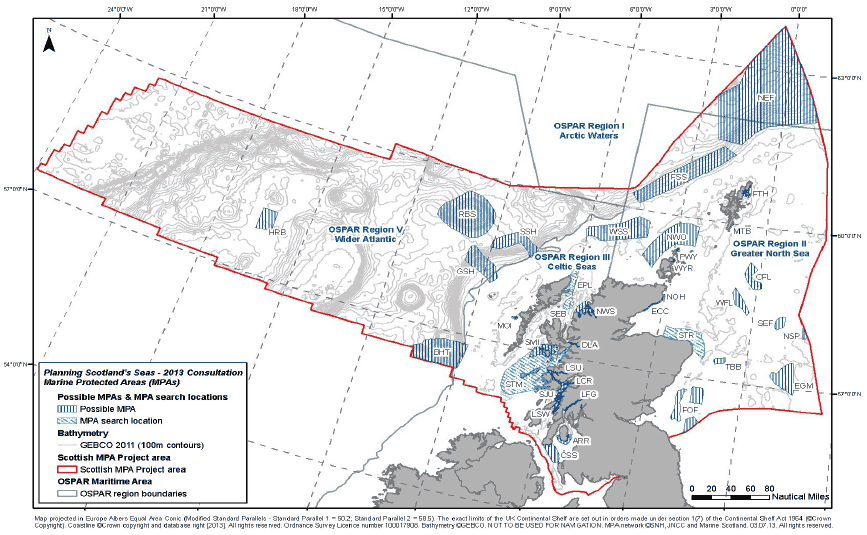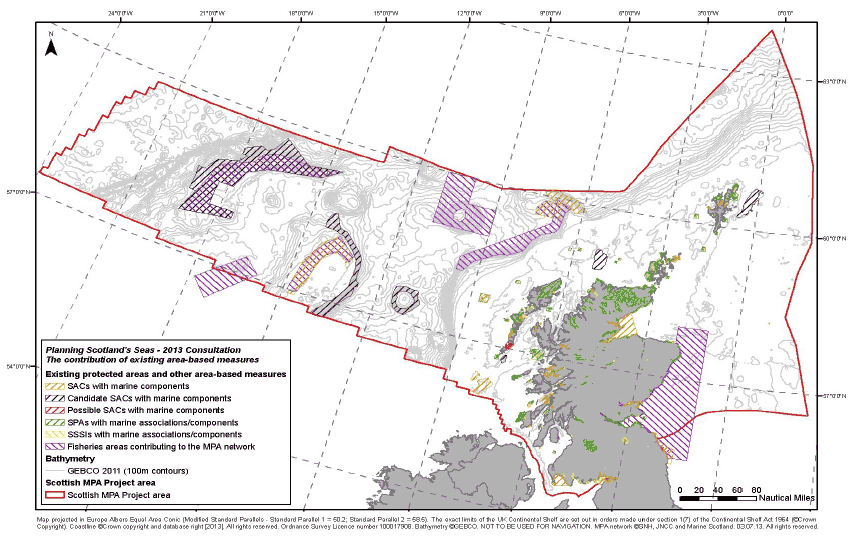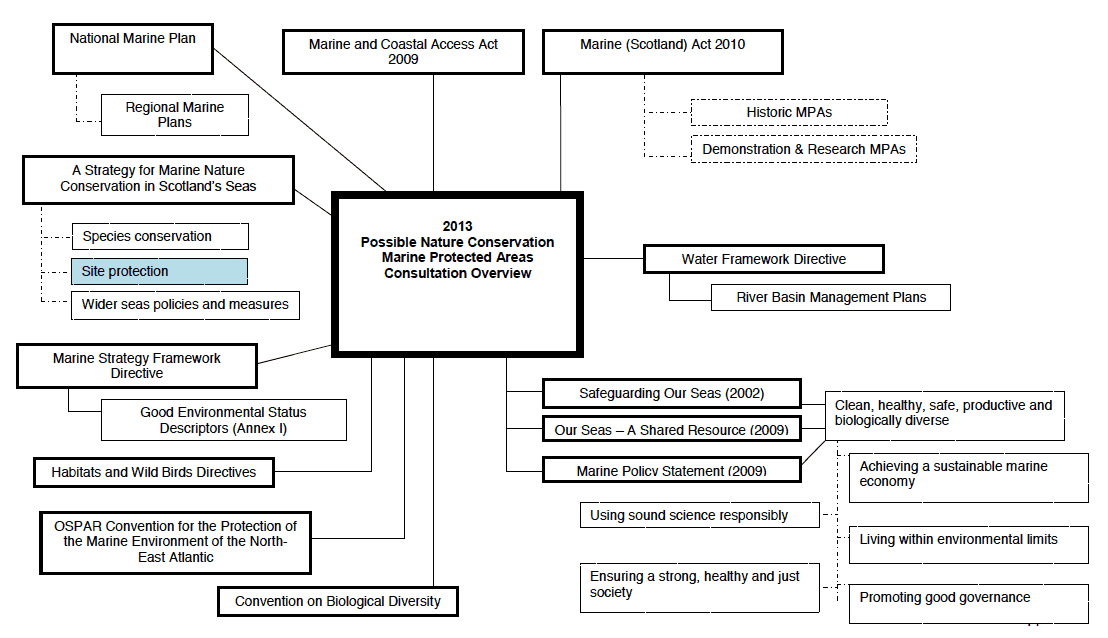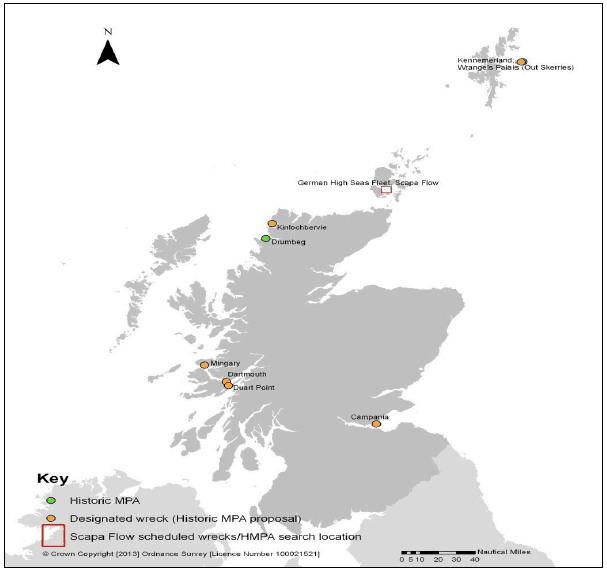Planning Scotland's Seas: 2013 - Possible Nature Conservation Marine Protected Areas Consultation Overview - Strategic Environmental Assessment Report
This report summarises the findings from a strategic environmental assessment (SEA) of the possible Marine Protected Areas (pMPAs).
2.0 2013 Possible Nature Conservation Marine Protected Areas Consultation Overview
Introduction
2.1 As noted in the introduction, the Marine (Scotland) Act 2010 and the Marine and Coastal Access Act 2009 both contain powers to designate Marine Protected Areas ( MPAs). These contribute to a range of measures to manage and protect Scotland's seas for current and future generations. The legislation also requires that a network of MPAs in UK seas is created to protect biodiversity and geodiversity. The network will contribute to agreements with international partners to create an ecologically coherent network of well-managed MPAs in the north-east Atlantic. The key overall objective of the MPA network is to safeguard the most important natural and cultural heritage features in Scottish waters, based on the principle of sustainable use [7] .
The Possible MPAs
2.2 Marine Scotland is working in partnership with Scottish Natural Heritage ( SNH), the Joint Nature Conservation Committee ( JNCC), the Scottish Environment Protection Agency ( SEPA) and Historic Scotland ( HS). SNH and JNCC have provided joint scientific advice (as statutory nature conservation bodies) on existing protected areas and other area-based measures that contribute to the network and have identified possible Nature Conservation MPAs that could form part of a network to protect biodiversity and geodiversity [8] . A significant part of the work underlying this advice has been based around ensuring that network and feature coverage satisfies the OSPAR principles of developing an ecologically coherent network.
2.3 Thirty-three possible Nature Conservation MPAs have been identified, and a further four MPA search locations remain to be fully assessed ( Table 1 and Figure 2). The evolving MPA network in Scotland's seas builds on the existing network of protected areas ( Figure 3), which includes Special Areas of Conservation ( SACs); Special Protection Areas ( SPAs); Sites of Special Scientific Interest ( SSSIs), and fisheries management areas. More information on these other designations and sites is provided in the SNH/ JNCC advice [8] .
2.4 Details of the protected features for each pMPA are provided in Table 2. Key facts about the proposals are summarised in Table 3.
Table 1. Possible Nature Conservation MPAs and MPA search locations (*) in Scottish waters (by sea area)
| OSPAR Region(s) | Possible MPA/ MPA search location | Code | Territorial / Offshore |
|---|---|---|---|
| I | Faroe-Shetland sponge belt | FSS | Offshore |
| I & II | North-east Faroe Shetland Channel | NEF | Offshore |
| II | Central Fladen | CFL | Offshore |
| East Caithness Cliffs | ECC | Territorial | |
| East of Gannet and Montrose Fields | EGM | Offshore | |
| Fetlar to Haroldswick | FTH | Territorial | |
| Firth of Forth Banks Complex | FOF | Offshore | |
| Mousa to Boddam | MTB | Territorial | |
| North-west Orkney | NWO | Both | |
| Norwegian boundary sediment plain | NSP | Offshore | |
| Noss Head | NOH | Territorial | |
| Papa Westray | PWY | Territorial | |
| South-east Fladen | SEF | Offshore | |
| Southern Trench* | STR | Territorial | |
| Turbot Bank | TBB | Offshore | |
| Western Fladen | WFL | Offshore | |
| Wyre and Rousay Sounds | WYR | Territorial | |
| II & III | West Shetland Shelf | WSS | Offshore |
| III | Clyde Sea Sill | CSS | Territorial |
| Eye Peninsula to Butt of Lewis* | EPL | Territorial | |
| Loch Creran | LCR | Territorial | |
| Lochs Duich, Long and Alsh | DLA | Territorial | |
| Loch Sunart | LSU | Territorial | |
| Loch Sunart to the Sound of Jura | SJU | Territorial | |
| Loch Sween | LSW | Territorial | |
| Monach Isles | MOI | Territorial | |
| North-west sea lochs and Summer Isles | NWS | Territorial | |
| Shiant East Bank* | SEB | Territorial | |
| Skye to Mull* | STM | Territorial | |
| Small Isles | SMI | Territorial | |
| South Arran | ARR | Territorial | |
| Upper Loch Fyne and Loch Goil | LFG | Territorial | |
| III & V | Geike Slide and Hebridean Slope | GSH | Offshore |
| South-west Sula Sgeir and Hebridean Slope | SSH | Offshore | |
| The Barra Fan and Hebrides Terrace Seamount | BHT | Offshore | |
| V | Hatton-Rockall Basin | HRB | Offshore |
| Rosemary Bank Seamount | RBS | Offshore |
Figure 2. Possible Nature Conservation MPAs and search locations in Scotland's seas

Figure 3. The contribution of existing protected areas and other area-based measures to the MPA network

Table 2. Protected Features - Biodiversity and Geodiversity - for each pMPA
| Name | Code | Protected features | Conservation objective |
|---|---|---|---|
| Territorial waters | |||
| Clyde Sea Sill | CSS | Biodiversity protected features - Black guillemot; circalittoral sand and coarse sediment communities; fronts Geodiversity protected features - Marine Geomorphology of the Scottish Shelf Seabed - sand banks, sand ribbon fields, sand wave fields |
conserve |
| East Caithness Cliffs | ECC | Biodiversity protected features - Black guillemot | conserve |
| Fetlar to Haroldswick | FTH | Biodiversity protected features - Black guillemot; circalittoral sand and coarse sediment communities; horse mussel beds; kelp and seaweed communities on sublittoral sediments; maerl beds; shallow tide-swept coarse sands with burrowing bivalves Geodiversity protected features - Marine Geomorphology of the Scottish Shelf Seabed |
conserve |
| Loch Creran | LCR | Biodiversity protected features - Flame shell beds Geodiversity protected features - Quaternary of Scotland |
conserve |
| Lochs Duich, Long and Alsh | DLA | Biodiversity protected features - Burrowed mud, flame shell beds | conserve |
| Loch Sunart | LSU | Biodiversity protected features - Flame shell beds; northern feather star aggregations on mixed substrata; serpulid aggregations | conserve |
| Loch Sunart to the Sound of Jura | SJU | Biodiversity protected features - Common skate Geodiversity protected features - Quaternary of Scotland |
conserve |
| Loch Sween | LSW | Biodiversity protected features - Burrowed mud; maerl beds; native oysters; sublittoral mud and mixed sediment communities | conserve |
| Monach Isles | MOI | Biodiversity protected features - Black guillemot Geodiversity protected features - Marine Geomorphology of the Scottish Shelf Seabed; Quaternary of Scotland - landscape of areal glacial scour |
conserve |
| Mousa to Boddam | MTB | Biodiversity protected features - Sandeels Geodiversity protected features - Marine Geomorphology of the Scottish Shelf Seabed |
conserve |
| North-west sea lochs and Summer Isles | NWS | Biodiversity protected features - Burrowed mud; circalittoral muddy sand communities; flame shell beds; kelp and seaweed communities on sublittoral sediments; maerl beds; maerl or coarse shell gravel with burrowing sea cucumbers; northern feather star aggregations on mixed substrata Geodiversity protected features - Marine Geomorphology of the Scottish Shelf Seabed - banks of unknown substrate; Quaternary of Scotland - glaciated channels/troughs, megascale glacial lineations, moraines; Seabed Fluid and Gas Seep - pockmarks; Submarine Mass Movement - slide scars |
recover flame shell beds and maerl beds conserve other features |
| Noss Head | NOH | Biodiversity protected features - Horse mussel beds | conserve |
| Papa Westray | PWY | Biodiversity protected features - Black guillemot Geodiversity protected features - Marine Geomorphology of the Scottish Shelf Seabed - sand wave field |
conserve |
| Small Isles | SMI | Biodiversity protected features - Black guillemot; burrowed mud, circalittoral sand and mud communities; fan mussel aggregations; horse mussel beds; northern feather star aggregations on mixed substrata; northern sea fan and sponge communities; shelf deeps; white cluster anemones Geodiversity protected features - Quaternary of Scotland - glaciated channels/troughs, glacial lineations, meltwater channels, moraines, rock basins, streamlined bedforms |
conserve |
| South Arran | ARR | Biodiversity protected features - Burrowed mud; herring spawning grounds; kelp and seaweed communities on sublittoral sediments; maerl beds; maerl or coarse shell gravel with burrowing sea cucumbers; ocean quahog; seagrass beds; shallow tide-swept coarse sands with burrowing bivalves | recover maerl beds conserve other features |
| Upper Loch Fyne and Loch Goil | LFG | Biodiversity protected features - Burrowed mud; flame shell beds; horse mussel beds; ocean quahog; sublittoral mud and mixed sediment communities | recover flame shell beds conserve other features |
| Wyre and Rousay Sounds | WYR | Biodiversity protected features - Kelp and seaweed communities on sublittoral sediment; maerl beds Geodiversity protected features - Marine Geomorphology of the Scottish Shelf Seabed |
conserve |
| Offshore waters | |||
| Central Fladen | CFL | Biodiversity protected features - Burrowed mud Geodiversity protected features - Quaternary of Scotland - sub-glacial tunnel valley |
conserve |
| East of Gannet and Montrose Fields | EGM | Biodiversity protected features - Ocean quahog aggregations (including sands and gravels as their supporting habitat); offshore deep sea muds | conserve |
| Faroe-Shetland sponge belt | FSS | Biodiversity protected features - Continental slope; deep-sea sponge aggregations; ocean quahog aggregations; offshore subtidal sands and gravels Geodiversity protected features - Marine Geomorphology of the Scottish Deep Ocean Seabed - sand wave field, sediment wave field; Quaternary of Scotland - continental slope channels; iceberg ploughmark fields, prograding wedges; Submarine Mass Movement - slide deposits |
conserve |
| Firth of Forth Banks Complex | FOF | Biodiversity protected features - Ocean quahog aggregations; offshore subtidal sands and gravels; shelf banks and mounds Geodiversity protected features - Quaternary of Scotland - moraines |
conserve |
| Geikie Slide and Hebridean slope | GSH | Biodiversity protected features - Burrowed mud; continental slope; offshore deep-sea muds, offshore subtidal sands and gravels Geodiversity protected features - Submarine Mass Movement - slide deposits, slide scars |
conserve |
| Hatton-Rockall Basin | HRB | Biodiversity protected features - Deep-sea sponge aggregations; offshore deep-sea muds Geodiversity protected features - Marine Geomorphology of the Scottish Deep Ocean Seabed - sediment drifts; Polygonal fault systems |
conserve |
| North-east Faroe Shetland Channel | NEF | Biodiversity protected features - Continental slope; deep-sea sponge aggregations; offshore deep-sea muds; offshore subtidal sands and gravels Geodiversity protected features - Cenozoic Structures of the Atlantic Margin - mud diapirs; Marine Geomorphology of the Scottish Deep Ocean Seabed - contourite sand/silt; Quaternary of Scotland - prograding wedge; Submarine Mass Movement - slide deposits |
conserve |
| North-west Orkney | NWO | Biodiversity protected features - Sandeels Geodiversity protected features - Marine Geomorphology of the Scottish Shelf Seabed - sand bank, sand wave field, sediment wave fields |
conserve |
| Norwegian boundary sediment plain | NSP | Biodiversity protected features - Ocean quahog aggregations (including sands and gravels as their supporting habitat), offshore subtidal sands and gravels | conserve |
| Rosemary Bank Seamount | RBS | Biodiversity protected features - Deep-sea sponge aggregations; seamount features; seamount communities Geodiversity protected features - Cenozoic Structures of the Atlantic Margin - Rosemary Bank Seamount; Marine Geomorphology of the Scottish Deep Ocean Seabed - scour moats, sediment drifts, sediment wave fields; Quaternary of Scotland - iceberg ploughmark field; Submarine Mass Movement - slide scars |
conserve |
| South-east Fladen | SEF | Biodiversity protected features - Burrowed mud Geodiversity protected features - Seabed Fluid and Gas Seep - pockmarks |
conserve |
| South-west Sula Sgeir and Hebridean slope | SSH | Biodiversity protected features - Burrowed mud; continental slope; offshore deep-sea muds; offshore subtidal sands and gravels Geodiversity protected features - Quaternary of Scotland - iceberg ploughmark fields, prograding wedges; Submarine Mass Movement - slide deposits |
conserve |
| The Barra Fan and Hebrides Terrace Seamount | BHT | Biodiversity protected features - Burrowed mud; continental slope; offshore deep-sea muds; offshore subtidal sands and gravels; orange roughy; seamount; seamount communities Geodiversity protected features - Cenozoic Structures of the Atlantic Margin - continental slope, Hebrides Terrace Seamount; Marine Geomorphology of the Scottish Deep Ocean Seabed - scour moat; Quaternary of Scotland - iceberg ploughmark field, prograding wedges; Submarine Mass Movement - continental slope turbidite canyons, slide deposits |
conserve |
| Turbot Bank | TBB | Biodiversity protected features - Sandeels, offshore subtidal sands and gravels, shelf banks and mounds | conserve |
| West Shetland Shelf | WSS | Biodiversity protected features - Offshore subtidal sands and gravels | conserve |
| Western Fladen | WFL | Biodiversity protected features - Burrowed mud Geodiversity protected features - Quaternary of Scotland - sub-glacial tunnel valleys |
conserve |
2.5 The Scottish MPA Selection Guidelines [9] set out a five-stage process for the selection of Nature Conservation MPAs in Scotland's seas:
- Stage 1: Identification of search locations based on presence of key features
- Stage 2: Prioritisation of search locations based on the qualities of their features
- Stage 3: Assessment of the size an MPA needs to be, to be effective
- Stage 4: Assessment of the ability to manage features effectively
- Stage 5: Prioritising potential areas according to their contribution to the network
More detail about the process is provided in Section 4. A full description is set out in Marine Scotland's Report to the Scottish Parliament (2012) [7] .
2.6 The focus of the possible MPAs is to either:
- protect a range of biodiversity or geodiversity features in their current state for the future, or
- to allow them to recover to the state they should be to remain healthy and productive.
This is reflected in the conservation objective identified for each pMPA ( Table 2).
2.7 The MPAs will be managed to achieve their conservation objectives, using the principle of sustainable use. This means that only activities that present a risk of hindering the achievement of the conservation objectives will have specific management measures implemented.
2.8 Management options papers have been produced for each of the pMPAs. These papers use a risk-based approach to identify management options, based on the protected features, the conservation objectives, and the activities which could affect their condition. Management options are a key element of the consultation, which provides opportunities for stakeholders to present their views, including their practical environmental knowledge and activity data.
Policy Context
2.9 The Environmental Assessment (Scotland) Act 2005 requires that the Environmental Report include an outline of the relationships between the possible MPAs and other relevant plans, programmes and strategies. The policy context for the development of the possible MPAs is illustrated in Figure 4.
2.10 MPAs are a key element of Scottish Ministers' three-pillar approach to marine nature conservation (site protection, species protection and wider seas policies and measures).
Table 3. Key Facts About the Possible MPAs
| Responsible Authority | Marine Scotland |
|---|---|
| Title of PPS | 2013 Possible Nature Conservation Marine Protected Areas Consultation Overview |
| Purpose of PPS | To identify possible nature conservation MPAs that will contribute to an ecologically coherent network of MPAs |
| What prompted the PPS | Marine (Scotland) Act 2010 and Marine and Coastal Access Act 2009 |
| Subject | Marine biodiversity and geodiversity |
| Period covered by PPS | 2014 onwards |
| Frequency of updates | The achievement of conservation objectives is required to be reviewed and reported on every six years |
| Area covered by PPS | Scottish territorial waters (0-12 nautical miles) and Scottish offshore waters (12-200 nautical miles) |
| Summary of nature/ content of PPS | The consultation document identifies possible nature conservation MPAs in Scotland's seas |
| Are there any proposed PPS objectives? | Yes. The key overall objective of the nature conservation MPA network is to safeguard the most important natural heritage features in Scottish waters, based on the principle of sustainable use. In addition each feature has its own conservation objective(s). |
| Copy of objectives attached | Conservation objectives are provided in Table 2. |
| Date | August 2013 |
| Contact | Amanda Chisholm, Environmental Assessment Team 2J South Victoria Quay Edinburgh EH6 6QQ tel. 0131 244 7806 email: amanda.chisholm@scotland.gsi.gov.uk Sebastian Howell, Marine Scotland 1A South Victoria Quay Edinburgh EH6 6QQ tel: 0131 244 5301 email: sebastian.howell@scotland.gsi.gov.uk |
Figure 4. Policy Context for the possible MPAs

Historic MPAs
2.11 Scotland's first Historic Marine Protected Area ( HMPA) was designated on 18 March 2013, to protect an historic wreck close to the harbour of Drumbeg, Sutherland ( Figure 5). On the same day, Historic Scotland also launched a consultation to make the Drumbeg designation permanent, and to designate a further six HMPAs. These comprise historic wreck sites currently designated under section 1 of the Protection of Wrecks Act 1973.
2.12 In 2013-14, Historic Scotland is progressing consideration of an HMPA for Scapa Flow's outstanding underwater heritage. This involves review and transition to HMPA status for the seven intact wrecks of the German High Seas Fleet scuttled in Scapa Flow in 1919, currently scheduled monuments, and consideration of any other underwater sites relating to Scapa Flow's wartime naval heritage for inclusion in an HMPA proposal for consultation in 2014 ( Figure 5). A small number of other high priority sites may be considered for designation as HMPAs before 2015.
Figure 5. Historic MPAs (current and possible)

Contact
There is a problem
Thanks for your feedback